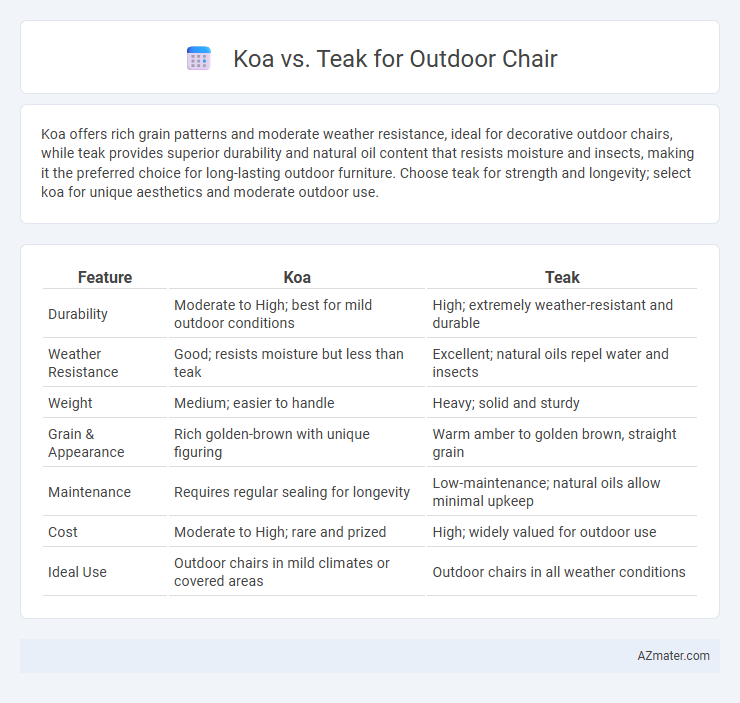Koa offers rich grain patterns and moderate weather resistance, ideal for decorative outdoor chairs, while teak provides superior durability and natural oil content that resists moisture and insects, making it the preferred choice for long-lasting outdoor furniture. Choose teak for strength and longevity; select koa for unique aesthetics and moderate outdoor use.
Table of Comparison
| Feature | Koa | Teak |
|---|---|---|
| Durability | Moderate to High; best for mild outdoor conditions | High; extremely weather-resistant and durable |
| Weather Resistance | Good; resists moisture but less than teak | Excellent; natural oils repel water and insects |
| Weight | Medium; easier to handle | Heavy; solid and sturdy |
| Grain & Appearance | Rich golden-brown with unique figuring | Warm amber to golden brown, straight grain |
| Maintenance | Requires regular sealing for longevity | Low-maintenance; natural oils allow minimal upkeep |
| Cost | Moderate to High; rare and prized | High; widely valued for outdoor use |
| Ideal Use | Outdoor chairs in mild climates or covered areas | Outdoor chairs in all weather conditions |
Introduction to Koa and Teak Wood
Koa wood, native to Hawaii, is prized for its rich grain patterns, warm tones, and excellent durability, making it a popular choice for high-end outdoor furniture. Teak wood, harvested primarily from Southeast Asia, is renowned for its natural oil content that provides exceptional resistance to moisture, decay, and insect damage, ideal for outdoor chair construction. Both woods offer unique aesthetic and structural qualities that cater to different preferences and environmental conditions in outdoor settings.
Origin and Availability of Koa vs Teak
Koa wood, native to Hawaii, is prized for its rich color and durability but is limited in availability due to its geographic specificity and conservation efforts. Teak, sourced primarily from Southeast Asia, offers widespread availability and is sustainably harvested from plantations, making it a more accessible option for outdoor furniture. Both woods are valued for their weather resistance, but teak's broader market presence often ensures easier procurement and competitive pricing.
Appearance and Aesthetic Differences
Koa wood offers a rich, warm appearance with a striking grain pattern featuring curly, wavy, or tiger-striping effects that create a luxurious, natural aesthetic for outdoor chairs. Teak wood displays a more uniform, golden-brown hue that ages gracefully to a silvery-gray patina over time, providing a classic and timeless look. The vibrant color variations and unique figuring of Koa make each chair a standout piece, while teak's consistent texture and weather-resistant qualities appeal to those seeking enduring elegance in outdoor furniture.
Durability and Weather Resistance
Teak wood offers exceptional durability and weather resistance for outdoor chairs due to its high natural oil content, making it highly resistant to rot, insects, and moisture over decades. Koa, while also durable and aesthetically appealing with a rich grain, is less resistant to prolonged exposure to harsh weather and typically requires more maintenance to prevent fading and cracking. For long-term outdoor use in varying climates, teak is generally preferred for its superior strength and minimal upkeep requirements.
Maintenance Requirements
Koa wood requires regular maintenance including periodic oiling and sealing to preserve its rich color and prevent weather damage, making it slightly higher maintenance compared to teak. Teak naturally contains oils that resist moisture, insects, and decay, allowing it to withstand outdoor conditions with minimal upkeep, typically requiring only occasional cleaning and re-oiling for optimal longevity. Both woods benefit from protective finishes to extend their lifespan, but teak's inherent durability reduces the frequency and intensity of maintenance tasks.
Environmental Impact and Sustainability
Koa wood, native to Hawaii, offers sustainable harvesting practices due to strict regulations and reforestation efforts, making it an eco-friendly option for outdoor chairs. Teak, despite its durability and natural resistance to decay, often faces environmental concerns from illegal logging and habitat loss, though certified teak from responsibly managed plantations can mitigate these impacts. Choosing koa supports conservation of native forests, while certified teak promotes sustainable forestry and reduced environmental footprint.
Cost Comparison: Koa vs Teak
Teak wood generally commands a higher price due to its widespread reputation for durability and natural resistance to weathering, making it a premium choice for outdoor chairs. Koa, while often more expensive than many hardwoods, can be competitively priced compared to teak, especially when sourced from sustainable Hawaiian plantations. The cost comparison between Koa and Teak largely depends on availability and sourcing, with teak typically incurring higher shipping and import fees that influence overall price.
Workability and Craftsmanship
Koa wood offers exceptional workability with its fine grain and natural luster, allowing craftsmen to achieve intricate details and smooth finishes on outdoor chairs. Teak's dense, oily composition makes it slightly more challenging to work with but provides superior durability and resistance to weathering, essential for long-lasting outdoor furniture. Both woods showcase outstanding craftsmanship potential, with Koa prized for its aesthetic richness and Teak for its robust structural integrity.
Comfort and Performance in Outdoor Settings
Koa wood offers a smooth, medium-hard texture that provides natural comfort and moderate durability for outdoor chairs, making it ideal for shaded patios. Teak is renowned for its exceptional resistance to moisture, insects, and weathering, ensuring long-lasting performance and a more supportive seating experience in varying outdoor conditions. Both woods develop a natural patina over time, but teak's high oil content enhances comfort by preventing splinters and warping, making it a superior choice for demanding outdoor environments.
Which Wood is Best for Your Outdoor Chair?
Koa wood offers exceptional durability and a rich, warm appearance that enhances outdoor chair aesthetics while resisting moisture and decay, making it highly suitable for long-term outdoor use. Teak wood is renowned for its natural oils that provide superior water resistance, strength, and longevity, ensuring outdoor chairs withstand harsh weather without warping or cracking. Choosing between Koa and Teak depends on balancing aesthetic preference with performance needs, but teak's proven resilience often makes it the best overall choice for outdoor furniture.

Infographic: Koa vs Teak for Outdoor Chair
 azmater.com
azmater.com